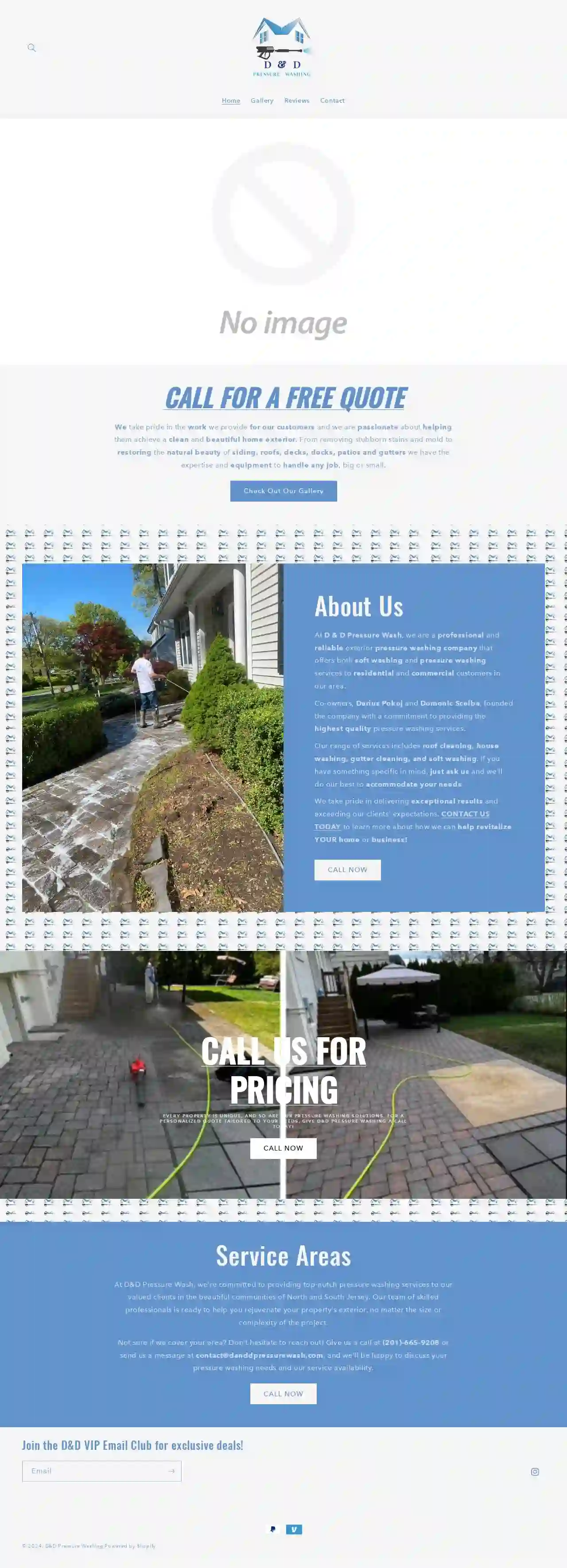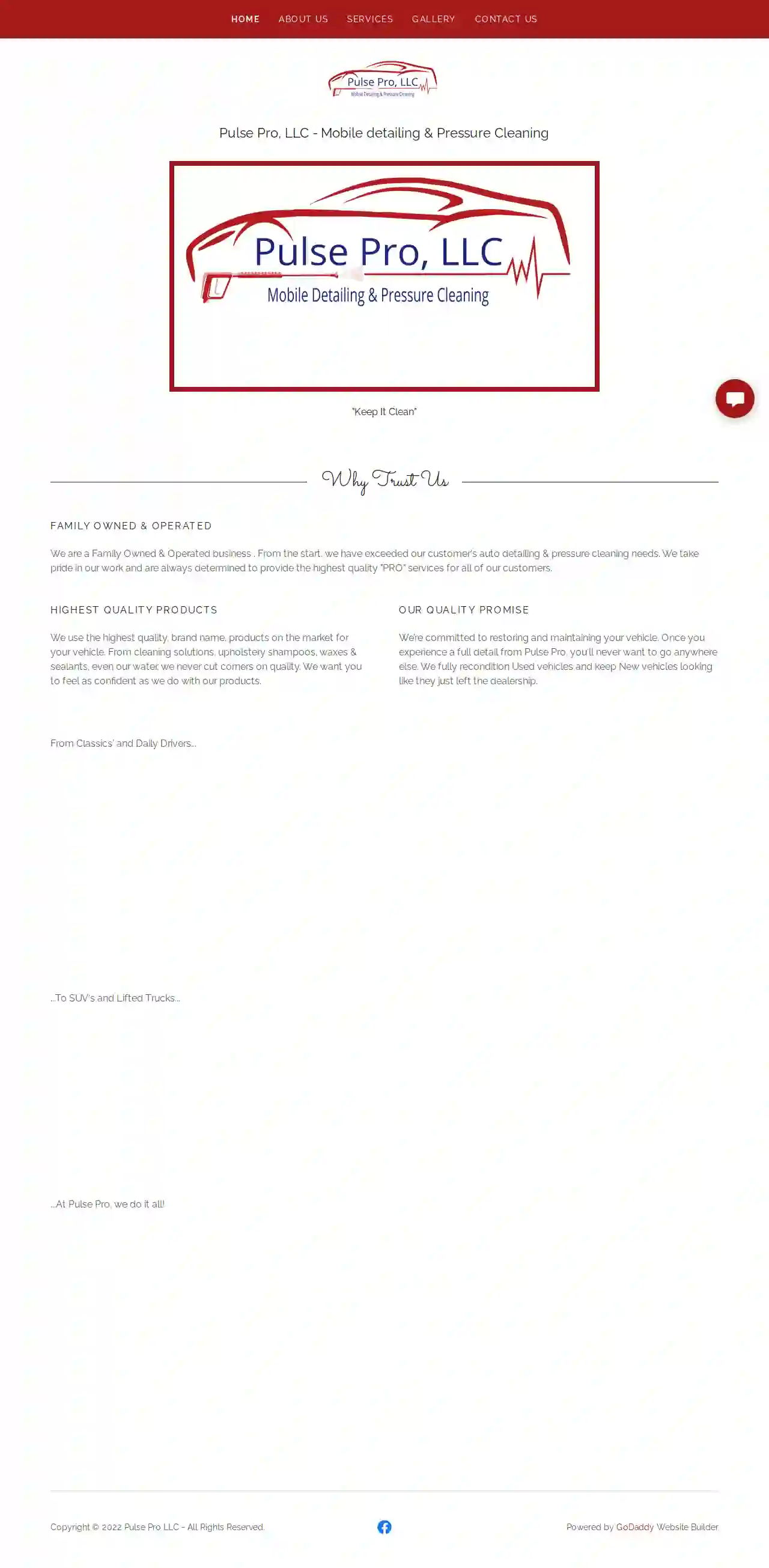Pressure Washing Spanish Fort
Find top Driveway Cleaning in Spanish Fort
Get multiple Commercial Pressure Washing quotes for your project today! Compare profiles, reviews, accreditations, portfolio, etc... and choose the best deal.

Evolved Pressure Washing, LLC
5189 reviewsMiddletown, NJ, 123 Main St, 07748, USEvolved Pressure Washing is your go-to source for all of your exterior cleaning needs. When you walk up to your home, we want you to be greeted with the clean and sparkling appearance that you deserve. To that end we constantly strive to deliver results that bring out the best curb appeal and quality that your home has ever had. Our pressure washing and soft washing services are designed to give every aspect of your home or business a completely fresh and clean appearance. You'll be amazed at how much a bright and clean roof, concrete, or siding can add to the overall aesthetic and curb appeal of your property. Based in Middletown, NJ and serving all of the Central New Jersey area, Evolved Pressure Washing has become synonymous with great service and amazing results over the past decade. Using our local knowledge and industry-leading pressure washing expertise, we are proud to bring convenience, quality, and reliability to every single client, every time.
- Services
- Why Us?
- Accreditations
- Our Team
- Testimonials
- Gallery
Get Quote
Abbadessa Bros Epoxy floors & Paver sealing
567 reviews21 Sonia Ct., Staten Island, 10309, USAbbadessa Bros is a professional pressure washing contractor proudly serving Staten Island. We are dedicated to keeping our city beautiful by providing high-quality pressure washing services using the best equipment and cleaning solutions. Our experienced team is committed to delivering exceptional results for both residential and commercial clients. We offer a wide range of services, including pressure washing, soft washing, paver sealing, roof cleaning, gutter cleaning, and epoxy flooring. We also service Brooklyn, Middletown, Colts Neck, and Manalapan.
- Services
- Why Us?
- Accreditations
- Our Team
- Testimonials
- Gallery
Get Quote
Apple Pro Wash
58 reviewsNorman, USExperience you can trust! Apple Pro Wash LLC is a firefighter owned and operated pressure washing business based out of Norman Oklahoma. We provide pressure and soft wash cleaning services for commercial businesses, residential houses, driveways, patios, sidewalks, decks and fences throughout the state of Oklahoma. We are licensed and fully insured! Give us a call for your free quote!
- Services
- Why Us?
- Gallery
Get Quote
Sani-Clean Powerwash & Sanitation
51 reviews11873 Valley View St, Ste #145, Garden Grove, 92845, USSani-Clean Powerwash & Sanitation is California's most trusted power wash and sanitation company. We provide top-notch sanitizing and pressure wash services that reveal true beauty and keep your space clean. Our commitment to sustainability means we use eco-friendly products and mitigate water waste ensuring your environment is left cleaner than ever before. We offer a variety of services for both commercial and residential clients, including drive thru, paver and sidewalk cleaning, building washing, dock and dumpster pad cleaning and sanitation, trash compactor service, repair & maintenance, equipment power washing, hazmat and bio hazardous room cleaning, and window cleaning. Our mission is to provide exceptional results, on-time and on-budget! We operate 24/7 without having to shut down your business or home for the chemical cleaning processes. We also keep your business compliant with the USDA, FDA, and OSHA regulations. We are dedicated to providing 1st class customer service and ensuring your satisfaction. We take and send photos pre and post-service to ensure we've exceeded your expectations. Your investment is protected by a variety of standards and benefits Sani-Clean provides. Give us a call today to get started!
- Services
- Why Us?
- Gallery
Get Quote
256 ProWash
572 reviewsHuntsville, US256 ProWash, LLC is a fully licensed and insured pressure washing company that focuses on safely and effectively cleaning the exterior areas of your home or business. Whether a one-time cleaning or on a routine schedule, we concentrate on both commercial and residential properties! 256 ProWash specializes in soft washing- which is a low-pressure, damage-free cleaning process for the exterior of your property. Don’t let the name fool you, soft washing can remove the tough stuff! In addition to improving its appearance, soft washing can extend the life of your property’s exterior. 256 ProWash, LLC Is A Family Owned And Operated Business That Provides The Highest Quality Pressure & Soft Washing Services To The Greater Huntsville Area of North Alabama.
- Services
- Why Us?
- Gallery
Get Quote
Curb Appeal Pressure Washing, LLC
532 reviews1106 West Hendrix Street, Brazil, 47834, USCurb Appeal Pressure Washing, LLC is your trusted source for elite soft wash house washing and pressure washing services in Indiana. We are dedicated to providing top-notch cleaning solutions for both residential and commercial properties, ensuring your property looks its best. Our team of professionals utilizes the latest techniques and equipment to deliver exceptional results while prioritizing safety and environmental responsibility. We understand the importance of curb appeal and strive to exceed your expectations with our meticulous cleaning services. Whether you need a complete exterior refresh, roof cleaning, concrete surface restoration, window washing, or fleet cleaning, we have the expertise and experience to handle it all. At Curb Appeal Pressure Washing, LLC, we believe in transparent pricing and exceptional customer service. We offer free quotes with no hidden charges and are committed to keeping you informed throughout the entire process. Contact us today to schedule a consultation and let us help you enhance the beauty and value of your property.
- Services
- Why Us?
- Gallery
Get Quote
Aqua Genie Pressure Washing
512 reviews11111 N 56th St, Suite 100, Tampa, 33619, USAqua Genie Pressure Washing is your one-stop shop for all your pressure washing needs in the greater Tampa Bay area. We are a family-owned and operated business with over 10 years of experience providing high-quality pressure washing services to residential and commercial clients. We are fully insured and licensed, and we take pride in our work. We offer a wide range of services, including house washing, driveway washing, deck washing, fence washing, and more. We use only the highest quality equipment and products to ensure that your property is cleaned to perfection. We are committed to providing our clients with exceptional service and results. Contact us today for a free estimate!
- Services
- Why Us?
Get Quote
D&D Pressure Wash
533 reviewsMobile, USWe take pride in the work we provide for our customers and we are passionate about helping them achieve a clean and beautiful home exterior. From removing stubborn stains and mold to restoring the natural beauty of siding, roofs, decks, docks, patios and gutters we have the expertise and equipment to handle any job, big or small. At D & D Pressure Wash, we are a professional and reliable exterior pressure washing company that offers both soft washing and pressure washing services to residential and commercial customers in our area. Co-owners, Darius Pokoj and Dominic Scelba, founded the company with a commitment to providing the highest quality pressure washing services. Our range of services includes house washing, paver restoration, gutter cleaning, roof cleaning, surface cleaning, and more!. If you have something specific in mind, just ask us and we'll do our best to accommodate your needs. We take pride in delivering exceptional results and exceeding our clients' expectations.
- Services
- Why Us?
- Our Team
- Testimonials
- Gallery
Get Quote
Shoals Pressure Washing
542 reviewsFlorence, AL, 123 Main St, 35630, USShoals Pressure Washing is a professional power washing company serving Florence Alabama and its surrounding areas, providing top-notch results for residential and commercial properties.
- Services
- Why Us?
- Accreditations
- Our Team
- Testimonials
- Gallery
Get Quote
Pulse Pro, LLC Mobile Detailing & Pressure Cleaning
510 reviewsMobile, US"Keep It Clean" Why Trust Us Family Owned & Operated We are a Family Owned & Operated business . From the start, we have exceeded our customer's auto detailing & pressure cleaning needs. We take pride in our work and are always determined to provide the highest quality "PRO" services for all of our customers. Highest Quality Products We use the highest quality, brand name, products on the market for your vehicle. From cleaning solutions, upholstery shampoos, waxes & sealants, even our water, we never cut corners on quality. We want you to feel as confident as we do with our products. Our Quality Promise We’re committed to restoring and maintaining your vehicle. Once you experience a full detail from Pulse Pro, you'll never want to go anywhere else. We fully recondition Used vehicles and keep New vehicles looking like they just left the dealership. From Classics' and Daily Drivers......To SUV's and Lifted Trucks...... At Pulse Pro, we do it all!
- Services
- Why Us?
- Gallery
Get Quote
Over 60,241+ Janitorial Services on our platform
Our janitorial companies operate in Spanish Fort & beyond!
CleaningMatch has curated and vetted the Best Janitorial Services near Spanish Fort. Find a trustworthy business today.
Frequently Asked Questions About Pressure Washing
- Enhanced Curb Appeal: Pressure washing removes dirt, grime, and stains, instantly revitalizing the appearance of your property and boosting curb appeal.
- Improved Health and Safety: Pressure washing removes mold, mildew, algae, and other contaminants that can pose health risks and create slippery surfaces.
- Increased Property Value: A well-maintained exterior, achieved through regular pressure washing, can increase the value of your property.
- Preventative Maintenance: Pressure washing removes dirt and grime that can deteriorate surfaces over time, extending the lifespan of your driveway, deck, fence, and other exterior features.
- Preparation for Painting or Staining: Pressure washing is an essential step before painting or staining, as it provides a clean and receptive surface for the new coating to adhere to.
- Soft Washing: Soft washing is generally recommended for wood decks as it uses lower pressure and specialized cleaning solutions to safely remove dirt, mildew, and algae without causing damage.
- Lower Pressure Setting: If using a pressure washer on a wood deck, use a lower pressure setting (around 1500 PSI) and a wide-angle nozzle (25-40 degrees).
- Maintain Distance: Hold the nozzle at least 12 inches away from the deck surface to prevent etching or splintering.
- Professional Pressure Washing: If you're unsure about pressure washing your deck safely, hire a professional pressure washing company with experience in cleaning wood surfaces.
- Experience and Expertise: Professionals have the knowledge and skills to choose the right pressure levels and cleaning solutions for different surfaces, minimizing the risk of damage.
- Professional Equipment: Pressure washing companies use commercial-grade equipment that is more powerful and efficient than consumer-grade pressure washers.
- Safety: Pressure washing can be hazardous, especially when working on ladders or with high-pressure water. Professionals are trained in safety procedures and have the necessary equipment to work safely.
- Time-Saving: Pressure washing can be time-consuming, especially for larger projects. Hiring professionals frees up your time for other tasks.
- Annually: Pressure washing your house at least once a year helps remove accumulated dirt, grime, and other contaminants, keeping it looking its best.
- Every 2-3 Years: If you live in an area with high humidity, heavy tree cover, or frequent exposure to pollutants, more frequent pressure washing may be necessary.
- When Visible Dirt and Grime Appear: Address visible dirt, stains, or mold growth promptly to prevent them from becoming more challenging to remove.
What are the benefits of pressure washing?
Whether you're looking to improve your property's appearance, protect its value, or enhance health and safety, pressure washing is a valuable investment.
Can pressure washing damage my deck?
By using the right cleaning method and precautions, you can effectively clean your wood deck without causing damage and prolong its lifespan.
Can I pressure wash my own house?
If you're considering DIY pressure washing, assess the complexity of the project, your experience, and the risks involved. For larger or more challenging projects, hiring professionals is often a wiser and safer choice.
How often should I pressure wash my house?
Regular pressure washing can maintain your home's exterior, extend the lifespan of your siding, and enhance its curb appeal.
What are the benefits of pressure washing?
- Enhanced Curb Appeal: Pressure washing removes dirt, grime, and stains, instantly revitalizing the appearance of your property and boosting curb appeal.
- Improved Health and Safety: Pressure washing removes mold, mildew, algae, and other contaminants that can pose health risks and create slippery surfaces.
- Increased Property Value: A well-maintained exterior, achieved through regular pressure washing, can increase the value of your property.
- Preventative Maintenance: Pressure washing removes dirt and grime that can deteriorate surfaces over time, extending the lifespan of your driveway, deck, fence, and other exterior features.
- Preparation for Painting or Staining: Pressure washing is an essential step before painting or staining, as it provides a clean and receptive surface for the new coating to adhere to.
Whether you're looking to improve your property's appearance, protect its value, or enhance health and safety, pressure washing is a valuable investment.
Can pressure washing damage my deck?
- Soft Washing: Soft washing is generally recommended for wood decks as it uses lower pressure and specialized cleaning solutions to safely remove dirt, mildew, and algae without causing damage.
- Lower Pressure Setting: If using a pressure washer on a wood deck, use a lower pressure setting (around 1500 PSI) and a wide-angle nozzle (25-40 degrees).
- Maintain Distance: Hold the nozzle at least 12 inches away from the deck surface to prevent etching or splintering.
- Professional Pressure Washing: If you're unsure about pressure washing your deck safely, hire a professional pressure washing company with experience in cleaning wood surfaces.
By using the right cleaning method and precautions, you can effectively clean your wood deck without causing damage and prolong its lifespan.
Can I pressure wash my own house?
- Experience and Expertise: Professionals have the knowledge and skills to choose the right pressure levels and cleaning solutions for different surfaces, minimizing the risk of damage.
- Professional Equipment: Pressure washing companies use commercial-grade equipment that is more powerful and efficient than consumer-grade pressure washers.
- Safety: Pressure washing can be hazardous, especially when working on ladders or with high-pressure water. Professionals are trained in safety procedures and have the necessary equipment to work safely.
- Time-Saving: Pressure washing can be time-consuming, especially for larger projects. Hiring professionals frees up your time for other tasks.
If you're considering DIY pressure washing, assess the complexity of the project, your experience, and the risks involved. For larger or more challenging projects, hiring professionals is often a wiser and safer choice.
How often should I pressure wash my house?
- Annually: Pressure washing your house at least once a year helps remove accumulated dirt, grime, and other contaminants, keeping it looking its best.
- Every 2-3 Years: If you live in an area with high humidity, heavy tree cover, or frequent exposure to pollutants, more frequent pressure washing may be necessary.
- When Visible Dirt and Grime Appear: Address visible dirt, stains, or mold growth promptly to prevent them from becoming more challenging to remove.
Regular pressure washing can maintain your home's exterior, extend the lifespan of your siding, and enhance its curb appeal.